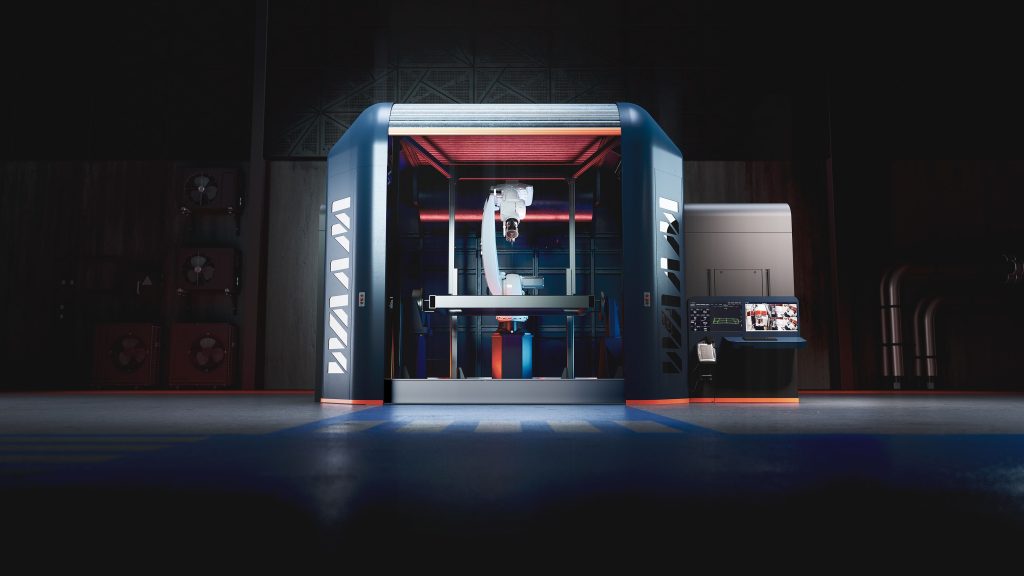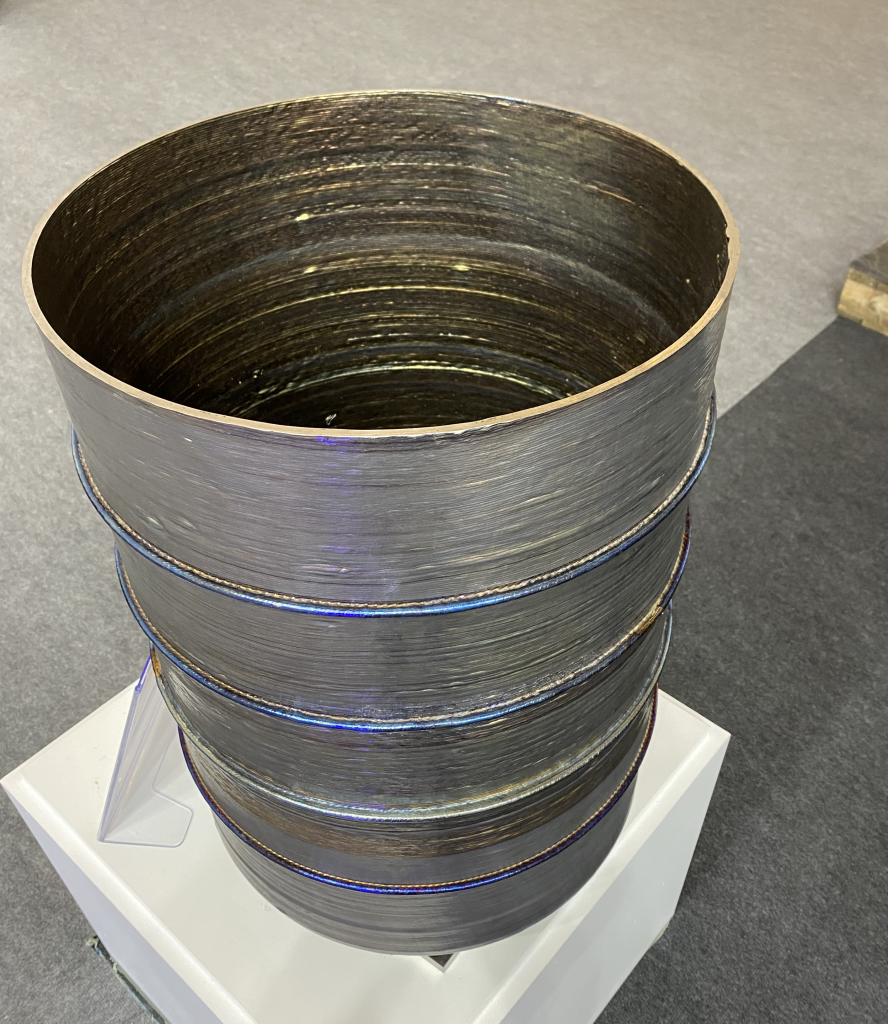Filomeno Martina, CEO of Wire Arc Additive Manufacturing (WAAM) specialists WAAM3D, spoke with 3D Printing Industry during Formnext 2023. The discussion saw Martina highlight the company’s position within the metal additive manufacturing industry, and outline WAAM3D’s long-term vision.
A Cranfield University spin-out, WAAM3D was founded in 2018 with the mission of industrializing and commercializing the WAAM process. The company now possesses an extensive portfolio dedicated to this goal, with a variety of hardware, software, and material offerings.
“We enable the implementation of large-scale wire-based direct energy deposition (DED),” explained Martina.
“We provide machinery dedicated to the process, we have several new process variants to enable high-productivity deposition, we have dedicated software which covers the entire digital workflow, and we also provide some very limited and specialized aluminum alloys for high-performance applications.”

Manufacturing Large-format, cost-effective parts with WAAM3D
Martina sees WAAM technology as complementing the metal additive manufacturing industry, offering possibilities unachievable with alternative metal 3D printing processes such as powder bed fusion (PBF).
“WAAM fills the gap left by PBF,” explained Martina. “Our technology sacrifices some of that precision and dimensional accuracy in favor of deposition speed and build size.”
Indeed, WAAM is optimized for the production of large-format metal parts for industrial applications. For instance, according to Martina, WAAM3D has 3D printed parts measuring seven meters and length, and weighing up to several hundred kilograms in mass. “So we are targeting very different applications to powder bed fusion,” added Martina.
One key vertical targeted by WAAM3D’s technology is aviation. Earlier this year, it was announced that WAAM3D had joined the I-Break (Landing Gear Industrial Breakthroughs) project. This £22.5M initiative includes collaboration from global aircraft OEM Airbus, and aims to develop lower-emission airplane landing gear components.
WAAM3D’s role within the I-Break project revolves around the industrialization of higher productivity WAAM variants. The Milton-Keynes-based company is also heading the control of microstructure and mechanical properties for high-integrity structural applications, and the industrialization of on-line non-destructive-testing techniques. WAAM3D RoboWAAM 3D printers are also being leveraged to manufacture demonstrator parts of relevant size and complexity.

Martina also highlighted that WAAM3D’s technology offers significant cost savings. “The main motivation for us is not so much design freedom, but typically a reduction in manufacturing costs when you compare WAAM to machining from solid or machining from forgings.”
Martina highlighted a titanium tank used on spacecraft for aerospace manufacturer Thales Alenia Space, which was being showcased at the WAAM3D booth. “On that tank, we are able to save 200 kg of material, making it 65% cheaper than conventional processes, and also 80% better from an environmental standpoint in terms of Co2 emitted and energy consumed.”
Martina also pointed to the benefits of WAAM3D technology within the energy and gas industry, especially with regard to securing supply chains. “Supply chains can be highly fragmented in geopolitically challenged areas, where the delivery of projects has a high risk of compromise,” explained Martina. “Having localized manufacturing capabilities with WAAM enables much shorter, less risky supply chains, enabling more predictable lead times and lower manufacturing risks.”

WAAM3D’s software packages
WAAM3D offer five software packages. These include WAAMCost, WAAMPlanner, WAAMKeys, WAAMSim, and WAAMCtrl.
WAAMCost, as the name suggests, can be used to estimate the production costs of WAAM 3D printing. In addition, this software can calculate the environmental impact of components 3D printed with WAAM3D technology. “This gives us the chance to evaluate the technical feasibility but also, more importantly, the financial feasibility and environmental feasibility of switching to WAAM,” explained Martina.
WAAMPlanner is the computer-aided manufacturing (CAM) engine for WAAM3D’s 3D printers. This software translates STEP files into machine files optimized for 3D printing on RoboWAAM systems. This software can also control physical stress and distortions during the 3D printing process, something which Martina highlights as being critical when 3D printing large parts.
Process parameters can be automatically calculated with WAAMKeys, allowing layer heights to be optimized and defects to be avoided. “That’s super useful for customers because they don’t have to work them out by themselves, which is very time consuming and expensive,” commented Martina.
WAAMSim is a simulation software that allows users to visualize the deposition process of their RoboWAAM 3D printer. “WAAMSim loads the programme and runs through it to check for collision detection and errors on the calibration,” stated Martina. Martina also noted that this software can be used as a training platform, with virtual reality (VR) capabilities allowing users to handle the 3D printer in a virtual environment, “so that you don’t have to take production hours away from the real system on the shop floor.”
Finally, Martina outlined his favorite software package as being WAAMCtrl, which he calls “the brain of the machine.” Here, data collected from 60 sensors is analyzed to enable process monitoring and control, and 3D printer management. “Ultimately, this software increases confidence in the process itself,” commented Martina. “While also improving the robustness, so that the process can reduce the number of failed builds, and can give the user more confidence in the quality of the parts.”

Differentiating within the WAAM market
WAAM3D is not the only company to commercialize WAAM technology, with companies such as AML3D and MX3D developing their own proprietary WAAM offerings. So what sets WAAM3D apart from the competition? According to Martina, it is the core R&D activities that were conducted at Cranfield University prior to the company’s launch.
“This has enabled us to produce software and hardware that is truly designed for the process,” commented Martina. “We are no longer talking about repurposed welding tools. We have brand new arc-based processes that enable us to achieve an incredible level of control, and a higher level of productivity.”
“We have not repurposed subtractive tools, we have designed new tools with additive manufacturing at the core of the requirements,” added Martina.
In addition, Martina pointed to the quality of personnel at WAAM3D. “30% of our staff have a PhD in a relevant area, typically in 3D printing,” explained Martina. “This means that, to date, there hasn’t been a challenge that we have not been able to solve when customers come to us.”
The future of WAAM3D
Looking to the future, Martina expects WAAM3D will continue to scale both geographically and technically.
“We deal with global companies that require global partners, because they are very large organizations with operations all over the world,” stated Martina. “To be able to support them, we have to match that breadth of geographical reach.”
In terms of technical scalability, Martina teased that WAAM3D is working on a number of novel technology offerings that will be rolled out over the coming years.
Subscribe to the 3D Printing Industry newsletter to keep up to date with the latest 3D printing news. You can also follow us on Twitter, like our Facebook page, and subscribe to the 3D Printing Industry Youtube channel to access more exclusive content.
Are you interested in working in the additive manufacturing industry? Visit 3D Printing Jobs to view a selection of available roles and kickstart your career.
Featured image shows WAAM3D CEO Filomeno Martina posing with a large-format WAAM3D printed part at Formnext 2023. Photo by 3D Printing Industry.


